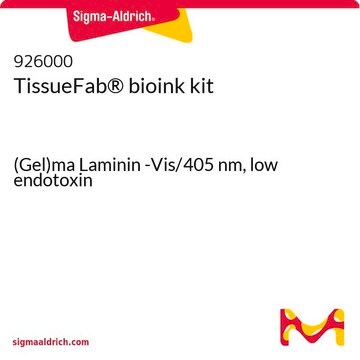927058
TissueFab® bioink kit
(Gel)ma Laminin -UV/365 nm, low endotoxin
Synonym(s):
0.2 um sterile filtered, 3D Bioprinting, GelMA, Gelatin methacrylamide, Gelatin methacrylate, Gelatin methacryloyl, Laminin
About This Item
Recommended Products
Quality Level
form
viscous liquid (gel)
impurities
<5 CFU/g Bioberden: Aerobic
<5 CFU/g Bioberden: Fungal
<50 EU/mL Endotoxin
color
pale yellow to colorless
pH
6.5-7.5
viscosity
3-30 cP
storage temp.
−20°C
Looking for similar products? Visit Product Comparison Guide
General description
Application
(Gel)ma Laminin -UV/365 nm, low endotoxin features a ready-to-use bioink that is formulated for high cell viability, and printability and is designed for extrusion-based 3D bioprinting and subsequent 365 nm light crosslinking and a solution of Laminin to enhance the bioink. The bioink kit can be used with most extrusion-based bioprinters, are biodegradable, and are compatible with human mesenchymal stem cells (hMSCs) and other diverse cell types. TissueFab®- Low endotoxin GelMA-UV Laminin kit enables the precise fabrication of 3D cell models and tissue constructs for research in 3D cell biology, tissue engineering, in vitro tissue models, and regenerative medicine. Suitable for final Laminin concentrations up to 200ug/ml.
Features and Benefits
Low Endotoxin, low bioburden: Endotoxins have been demonstrated negatively impact cellular growth, morphology, differentiation, inflammation and protein expression. Bioburden is defined as the number of contaminated organisms found in a given amount of material. We test each lot for endotoxins as well as total bioburden (aerobic and fungal) to minimize unwanted interactions. For more information: https://www.sigmaaldrich.com/US/en/technical-documents/technical-article/microbiological-testing/pyrogen-testing/what-is-endotoxin
Legal Information
related product
Storage Class Code
10 - Combustible liquids
Certificates of Analysis (COA)
Search for Certificates of Analysis (COA) by entering the products Lot/Batch Number. Lot and Batch Numbers can be found on a product’s label following the words ‘Lot’ or ‘Batch’.
Already Own This Product?
Find documentation for the products that you have recently purchased in the Document Library.
Our team of scientists has experience in all areas of research including Life Science, Material Science, Chemical Synthesis, Chromatography, Analytical and many others.
Contact Technical Service





